height Seat Leon 5D 2008 Owner's manual
[x] Cancel search | Manufacturer: SEAT, Model Year: 2008, Model line: Leon 5D, Model: Seat Leon 5D 2008Pages: 293, PDF Size: 8.67 MB
Page 8 of 293
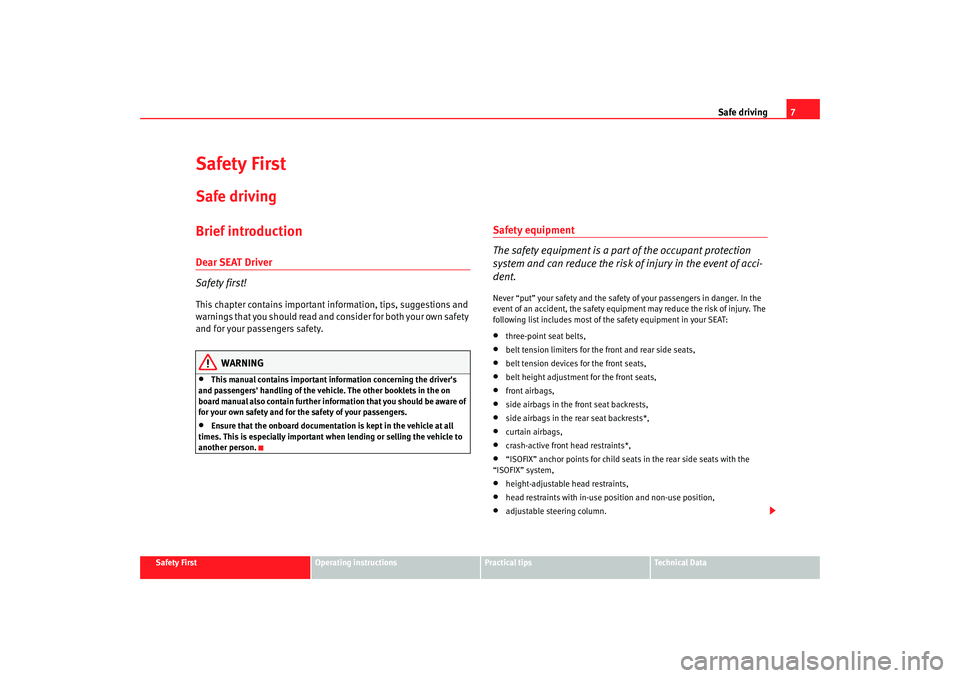
Safe driving7
Safety First
Operating instructions
Practical tips
Te c h n i c a l D a t a
Safety FirstSafe drivingBrief introductionDear SEAT Driver
Safety first!This chapter contains important information, tips, suggestions and
warnings that you should read and consider for both your own safety
and for your passengers safety.
WARNING
•
This manual contains important info rmation concerning the driver's
and passengers' handling of the vehicle. The other booklets in the on
board manual also contain further information that you should be aware of
for your own safety and for the safety of your passengers.
•
Ensure that the onboard documentatio n is kept in the vehicle at all
times. This is especially important when lending or selling the vehicle to
another person.
Safety equipment
The safety equipment is a part of the occupant protection
system and can reduce the risk of injury in the event of acci-
dent.Never “put” your safety and the safety of your passengers in danger. In the
event of an accident, the safety equipment may reduce the risk of injury. The
following list includes most of the safety equipment in your SEAT:•
three-point seat belts,
•
belt tension limiters for the front and rear side seats,
•
belt tension devices for the front seats,
•
belt height adjustment for the front seats,
•
front airbags,
•
side airbags in the front seat backrests,
•
side airbags in the rear seat backrests*,
•
curtain airbags,
•
crash-active front head restraints*,
•
“ISOFIX” anchor points for child seats in the rear side seats with the
“ISOFIX” system,
•
height-adjustable head restraints,
•
head restraints with in-use position and non-use position,
•
adjustable steering column.
leon_ingles Seite 7 Mont ag, 26. Januar 2009 4:29 16
Page 9 of 293
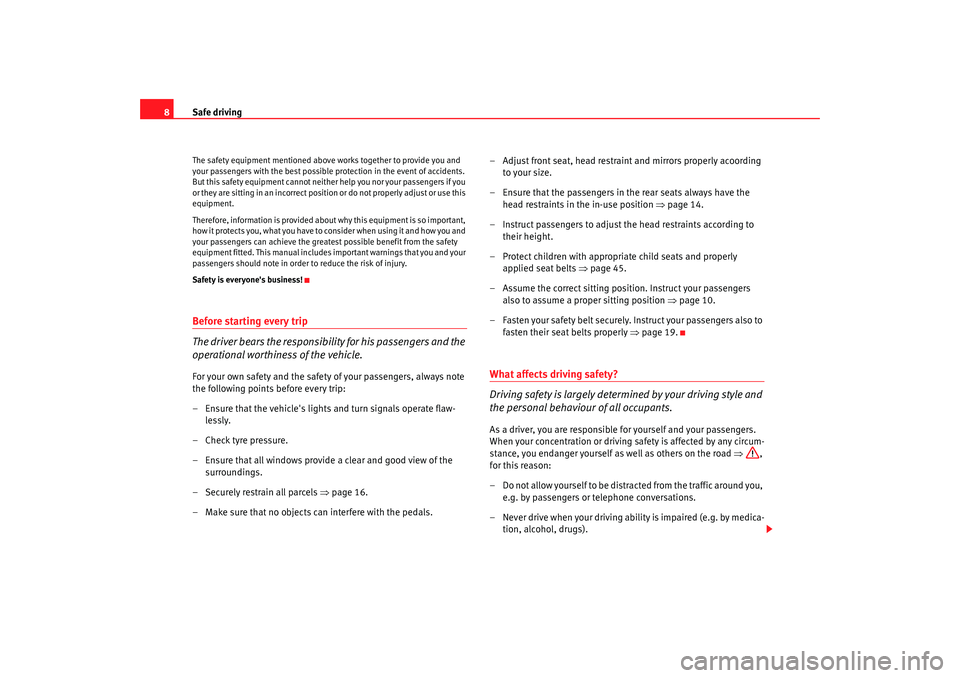
Safe driving
8The safety equipment mentioned above works together to provide you and
your passengers with the best possible protection in the event of accidents.
But this safety equipment cannot neither help you nor your passengers if you
or they are sitting in an incorrect position or d o not pro per ly adjust o r use this
equipment.
Therefore, information is provided about why this equipment is so important,
how it protects you, what you have to consider when using it and how you and
your passengers can achieve the greatest possible benefit from the safety
equipment fitted. This manual includes important warnings that you and your
passengers should note in order to reduce the risk of injury.
Safety is everyone's business!Before starting every trip
The driver bears the responsibility for his passengers and the
operational worthiness of the vehicle.For your own safety and the safety of your passengers, always note
the following points before every trip:
– Ensure that the vehicle's lights and turn signals operate flaw- lessly.
– Check tyre pressure.
– Ensure that all windows provide a clear and good view of the surroundings.
– Securely restrain all parcels ⇒page 16.
– Make sure that no objects can interfere with the pedals. – Adjust front seat, head restraint and mirrors properly acoording
to your size.
– Ensure that the passengers in the rear seats always have the head restraints in the in-use position ⇒page 14.
– Instruct passengers to adjust the head restraints according to their height.
– Protect children with appropriate child seats and properly applied seat belts ⇒page 45.
– Assume the correct sitting position. Instruct your passengers also to assume a proper sitting position ⇒ page 10.
– Fasten your safety belt securely. Instruct your passengers also to fasten their seat belts properly ⇒page 19.
What affects driving safety?
Driving safety is largely determined by your driving style and
the personal behaviour of all occupants.As a driver, you are responsible for yourself and your passengers.
When your concentration or driving safety is affected by any circum-
stance, you endanger yourself as well as others on the road ⇒,
for this reason:
– Do not allow yourself to be distracted from the traffic around you, e.g. by passengers or telephone conversations.
– Never drive when your driving ability is impaired (e.g. by medica- tion, alcohol, drugs).
leon_ingles Seite 8 Mont ag, 26. Januar 2009 4:29 16
Page 14 of 293

Safe driving13
Safety First
Operating instructions
Practical tips
Te c h n i c a l D a t a
Correct adjustment of front seat head restraints
Properly adjusted head restraints are an important part of
passengers protection and can reduce the risk of injuries in
most accident situations.
Adjust the head restraint properly in order to achieve maximum
protection.
– Adjust the head restraint so that its upper edge is at the same
level as the top of your head, or as close as possible to the same
level as the top of your head and, at the very least, at eye level
⇒fig. 3 and ⇒ fig. 4.Adjusting the head restraints ⇒page 127.
WARNING
•
Travelling with the head restrain ts removed or improperly adjusted
increases the risk of severe injuries.
•
Incorrectly adjusted head restraints could result in death in the event of
a collision or accident.
•
Incorrectly adjusted head restraints also increase the risk of injury
during sudden or unexpected driving or braking manoeuvres.
•
The head restraints must always be adjusted according to the
passenger's height.
Headrests in use*Vehicle occupants are pressed into their seats during a rear end collision. The
resulting body pressure on the backrest activates the crash-active head
restraint* on the front seat, which moves rapidly forwards and upwards at the
same time. This movement reduces the distance between the occupant's
head and the head rest, thus reducing the risk of head injuries such as brain
trauma.
Fig. 3 Properly adjusted
head restraint viewed
from the frontFig. 4 Properly adjusted
head restraint viewed
from the side
leon_ingles Seite 13 Montag, 26. Januar 2009 4:29 16
Page 15 of 293
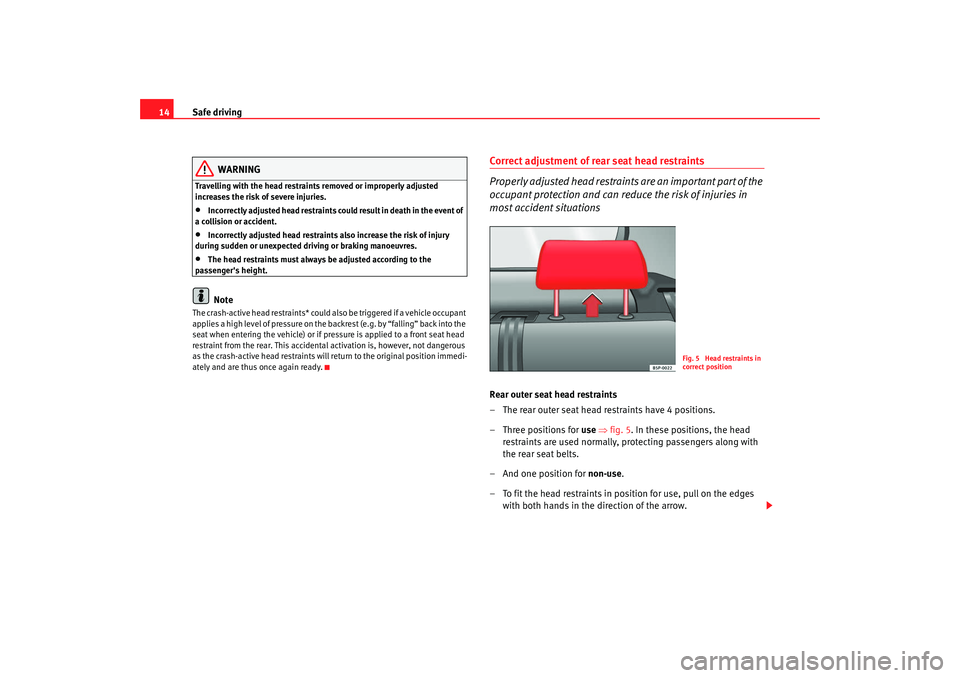
Safe driving
14
WARNING
Travelling with the head restraints removed or improperly adjusted
increases the risk of severe injuries.•
Incorrectly adjusted head restraints could result in death in the event of
a collision or accident.
•
Incorrectly adjusted head restraints also increase the risk of injury
during sudden or unexpected driving or braking manoeuvres.
•
The head restraints must always be adjusted according to the
passenger's height.Note
The crash-active head restraints* could also be triggered if a vehicle occupant
applies a high level of pressure on the backrest (e.g. by “falling” back into the
seat when entering the vehicle) or if pressure is applied to a front seat head
restraint from the rear. This accidental activation is, however, not dangerous
as the crash-active head restraints will return to the original position immedi-
ately and are thus once again ready.
Correct adjustment of rear seat head restraints
Properly adjusted head restraints are an important part of the
occupant protection and can redu ce the risk of injuries in
most accident situationsRear outer seat head restraints
– The rear outer seat head restraints have 4 positions.
–Three positions for use ⇒ fig. 5. In these positions, the head
restraints are used normally, protecting passengers along with
the rear seat belts.
– And one position for non-use.
– To fit the head restraints in position for use, pull on the edges with both hands in the direction of the arrow.
Fig. 5 Head restraints in
correct position
leon_ingles Seite 14 Montag, 26. Januar 2009 4:29 16
Page 20 of 293

Seat belts19
Safety First
Operating instructions
Practical tips
Te c h n i c a l D a t a
Seat beltsBrief IntroductionBefore driving: remember your seat belt!
Wearing a seat belt properly can save your life!In this chapter you will learn the importance of wearing seat belts,
how they work and how to properly fasten, adjust and wear them.
– Read and consider all the information as well as the warnings in
this chapter.
WARNING
•
If seat belts are worn incorrectly or not at all, the risk of severe injuries
increases.
•
Properly worn seat belts can reduce severe injuries in case of sudden
braking manoeuvres or accidents. For safety reasons, you and your passen-
gers must always wear the seat belts properly while the vehicle is moving.
•
Pregnant women or people with physical disabilities must also use seat
belts. Like all other passengers, these people can also sustain severe inju-
ries if they are not wearing their seat belts properly.
Number of seatsYour vehicle has five seats, two on the front part and three on the rear part.
Each seat is equipped with a three-point seat belt.
WARNING
•
More people than available seats must never be transported in your
vehicle.
•
Every passenger in the vehicle must properly fasten and wear the seat
belt belonging to his or her seat. Chil dren must be protected with an appro-
priate child restraint system.
Seat belt warning lamp*
The warning lamp acts as a reminder to the driver to fasten
the seat belt.Before starting the vehicle:
– Fasten your safety belt securely.
– Instruct your passengers to fasten their seat belts properly before driving off.
– Protect children by using a child seat according to the child's height and weight.After the ignition has been switched on, the warning lamp on the instru-
ment panel lights up
1) if the driver has not fastened his/her seat belt, and a
warning signal* is heard if the vehicle is driven at more than 30 km/h for 90
seconds.
1)Depending on the model version
leon_ingles Seite 19 Montag, 26. Januar 2009 4:29 16
Page 26 of 293

Seat belts25
Safety First
Operating instructions
Practical tips
Te c h n i c a l D a t a
The following features are available to adjust the seat belt in the shoulder
region:
•
belt height adjustment
for the front seats.
•
front seat height adjustment*.
WARNING
•
An incorrectly worn seat belt web can cause severe injuries in the event
of an accident.
•
The shoulder part of the seat belt must lie on the centre of the shoulder,
never across the neck. The seat belt must lie flat and snugly on the torso
⇒ page 24, fig. 12 .
•
The lap part of the seat belt must l ie across the pelvis, never across the
stomach. The seat belt must lie flat and snugly on the pelvis ⇒page 24,
fig. 13 . Pull the belt tight if necessary to take up any slack.
•
Read and observe the warnings ⇒page 22.
Pregnant women must also fasten their seat belts properly
The best protection for the unborn child is for the mother to
wear the seat belt properly at all times during the pregnancy.The seat belt provides maximum protection only when the belt web
is properly positioned ⇒page 24.
– Adjust the front seat and head restraint correctly ⇒page 10.
– Holding the latch plate, pull the belt evenly across your chest and as low as possible over the pelvis ⇒ fig. 14.
– Insert the latch plate into the buckle for the corresponding seat and push it down until it is securely locked with an audible click
⇒ .
– Pull the belt to ensure that the latch plate is securely engaged in the buckle.
Fig. 14 Positioning seat
belts during pregnancy
leon_ingles Seite 25 Montag, 26. Januar 2009 4:29 16
Page 27 of 293
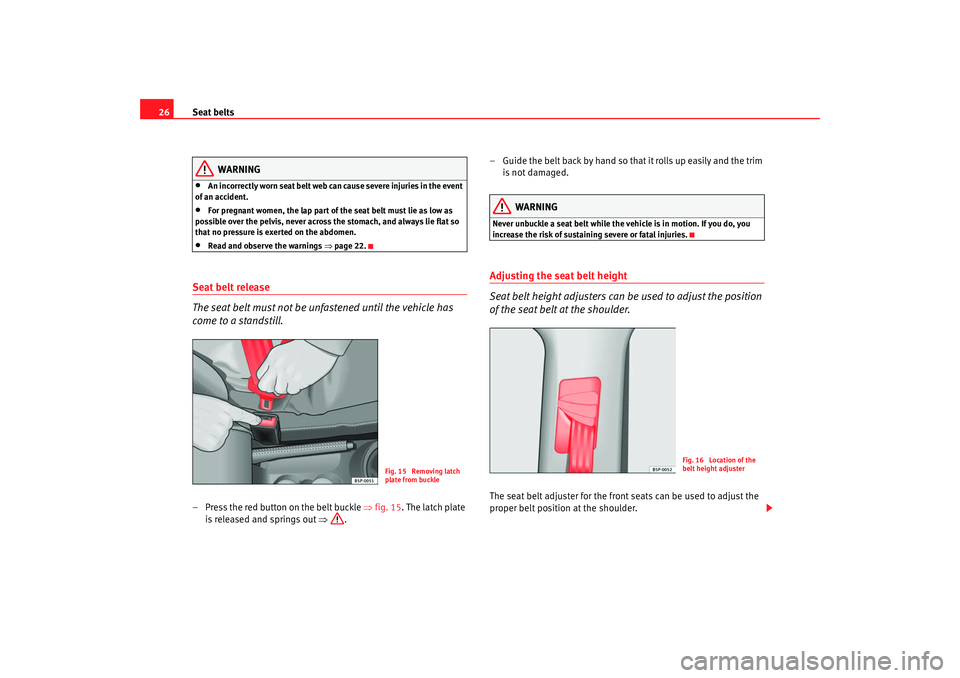
Seat belts
26
WARNING
•
An incorrectly worn seat belt web c an cause severe injuries in the event
of an accident.
•
For pregnant women, the lap part of the seat belt must lie as low as
possible over the pelvis, never across the stomach, and always lie flat so
that no pressure is exerted on the abdomen.
•
Read and observe the warnings ⇒ page 22.
Seat belt release
The seat belt must not be unfastened until the vehicle has
come to a standstill.– Press the red button on the belt buckle ⇒fig. 15 . The latch plate
is released and springs out ⇒. – Guide the belt back by hand so that it rolls up easily and the trim
is not damaged.
WARNING
Never unbuckle a seat belt while the vehicle is in motion. If you do, you
increase the risk of sustaining severe or fatal injuries.Adjusting the seat belt height
Seat belt height adjusters can be used to adjust the position
of the seat belt at the shoulder.The seat belt adjuster for the front seats can be used to adjust the
proper belt position at the shoulder.
Fig. 15 Removing latch
plate from buckle
Fig. 16 Location of the
belt height adjuster
leon_ingles Seite 26 Montag, 26. Januar 2009 4:29 16
Page 37 of 293
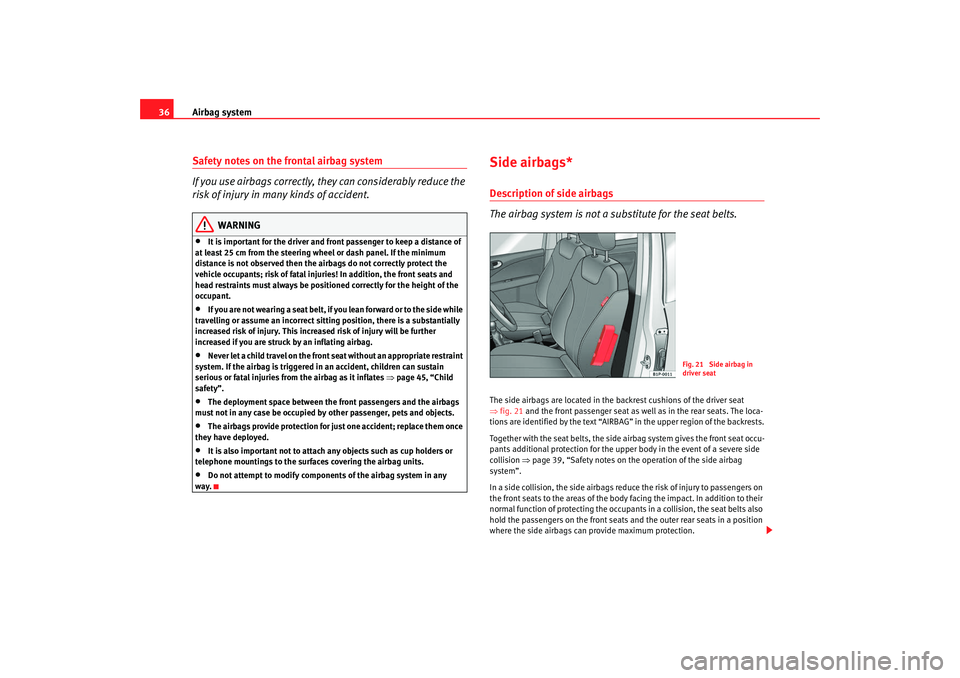
Airbag system
36Safety notes on the frontal airbag system
If you use airbags correctly, they can considerably reduce the
risk of injury in many kinds of accident.
WARNING
•
It is important for the driver and front passenger to keep a distance of
at least 25 cm from the steering wheel or dash panel. If the minimum
distance is not observed then the airbags do not correctly protect the
vehicle occupants; risk of fatal injuries! In addition, the front seats and
head restraints must always be positioned correctly for the height of the
occupant.
•
If you are not wearing a seat belt, if you lean forward or to the side while
travelling or assume an incorrect sitting position, there is a substantially
increased risk of injury. This increased risk of injury will be further
increased if you are struck by an inflating airbag.
•
Never let a child travel on the front seat without an appropriate restraint
system. If the airbag is triggered in an accident, children can sustain
serious or fatal injuries from the airbag as it inflates ⇒page 45, “Child
safety”.
•
The deployment space between the front passengers and the airbags
must not in any case be occupied by other passenger, pets and objects.
•
The airbags provide protection for just one accident; replace them once
they have deployed.
•
It is also important not to attach any objects such as cup holders or
telephone mountings to the surfaces covering the airbag units.
•
Do not attempt to modify components of the airbag system in any
way.
Side airbags*Description of side airbags
The airbag system is not a substitute for the seat belts.The side airbags are located in the backrest cushions of the driver seat
⇒ fig. 21 and the front passenger seat as well as in the rear seats. The loca-
tions are identified by the text “AIRBAG” in the upper region of the backrests.
Together with the seat belts, the side airbag system gives the front seat occu-
pants additional protection for the upper body in the event of a severe side
collision ⇒page 39, “Safety notes on the operation of the side airbag
system”.
In a side collision, the side airbags reduce the risk of injury to passengers on
the front seats to the areas of the body facing the impact. In addition to their
normal function of protecting the occupants in a collision, the seat belts also
hold the passengers on the front seats and the outer rear seats in a position
where the side airbags can provide maximum protection.
Fig. 21 Side airbag in
driver seat
leon_ingles Seite 36 Montag, 26. Januar 2009 4:29 16
Page 46 of 293

Child safety45
Safety First
Operating instructions
Practical tips
Te c h n i c a l D a t a
Child safetyBrief introductionIntroduction
Statistics show that children are generally safer on the rear
seat than on the front passenger seat.We recommend that children under 12 years of age are transported on the
rear seats. Children travelling on th e rear seat must use a child restraint
system or the seat belts provided, depending on their age, height and
weight. For safety reasons, the child r estraint system should be installed in
the centre of the rear seat or behind the front passenger's seat.
The physical laws involved and the forces acting in a collision apply also to
children ⇒page 20, “Why wear seat belts?”.
But unlike adults, children do not ha ve muscle and bone structures fully
developed. This means that children are subject to a greater risk of injury.
To reduce this risk, children must always use special child restraint systems
when travelling in the vehicle.
We recommend the use of child safety products from the SEAT Genuine Acces-
sories Program including systems for all ages made by “Peke”
2).
These systems have been especially designed and approved, complying with
the ECE-R44. regulation.
Follow the manufacturer's instructions and observe any statutory require-
ments when installing and using child seats. Always read and observe
⇒ page 46. We recommend you to include together
with the on-board documentation,
the manufacturer's Child Se at instructions manual.
2)Not for all countries
leon_ingles Seite 45 Montag, 26. Januar 2009 4:29 16
Page 47 of 293

Child safety
46Safety notes on using child seats
Proper use of child seats substantially reduces the risk of
injury in an accident!As the driver, you are responsible for any children you transport in
your vehicle.
– Protect your children by properly using appropriate child seats
⇒page 47.
– Always ensure that the belt webbing is properly positioned according to the instructions prov ided by the manufacturer of the
child seat.
– When travelling, do not allow children to distract you from traffic.
– Take breaks regularly during long trips. Take a break at least every two hours.
WARNING
•
Never install a child seat facing backwards (or rear-facing) on the front
passenger seat unless the front passenger airbag has been disabled. This
could lead to a risk of potentially fatal in juries to the child! However, if it is
necessary, in exceptional cases, to transport a child in the front passenger
seat, the front passenger airbag must always be disabled ⇒page 43,
“Deactivating airbags*”. If the passe nger seat has a height adjustment
option, move it to the highest position.
•
For those vehicles that do not include a key lock switch to turn the
airbag off, an Authorised Service Centre must be consulted.
•
All passengers, especially children, must assume the proper sitting
position and be properly belted in while travelling.
•
Never hold children or babies on your lap, this can result in potentially
fatal injuries to the child!
•
Never allow a child to be transported in a vehicle without being properly
secured, or to stand up or kneel on a seat while travelling. In an accident,
the child could be flung through the vehicle, causing possibly fatal injuries
to themselves and to the other passengers.
•
If children assume an improper sitting position when the car is moving,
they expose themselves to greater risk of injury in the event of sudden
braking manoeuvre or in an accident. This is particularly important if the
child is travelling on the front passenger seat and the airbag system is trig-
gered in an accident; as this could cause serious injury or even death.
•
A suitable child seat can protect your child!
•
Never leave an unsupervised child alone on a child seat or in the
vehicle.
•
Depending on weather conditions, it may become extremely hot or cold
inside the vehicle. This can be fatal.
•
Children who are less than 1.5 metres tall must not wear a normal seat
belt without a child restraint system, as this could cause injuries to the
abdominal and neck areas during a sudden braking manoeuvre or in an
accident.
•
Do not allow the belt webbing to become twisted or jammed, or to rub
on any sharp edges.
•
Incorrectly worn seat belts can cause injuries even in a minor collision
or in sudden braking manoeuvres.
•
The seat belt provides maximum prot ection only when the belt web is
properly positioned ⇒ page 23, “Seat belts”.
•
Only one child may occupy a child seat ⇒page 47, “Child seats”.WARNING (continued)
leon_ingles Seite 46 Montag, 26. Januar 2009 4:29 16